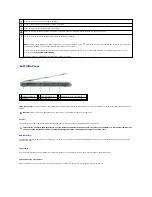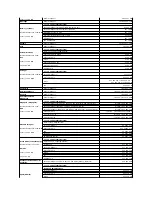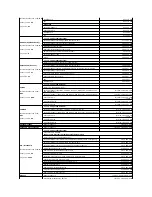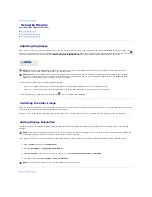
l
Click the
Start
button, click
Turn off computer
, and then click
Stand by
.
or
l
Depending on how you set the power management options in the
Power Options Properties
window or the QuickSet Power Management Wizard, use
one of the following methods:
¡
Press the power button.
¡
Close the display.
¡
Press <Fn><Esc>.
To exit standby mode, press the power button or open the display depending on how you set the power management options. You cannot make the computer
exit standby mode by pressing a key or touching the touch pad.
Hibernate Mode
Hibernate mode conserves power by copying system data to a reserved area on the hard drive and then completely turning off the computer. When the
computer exits hibernate mode, it returns to the same operating state it was in before entering hibernate mode.
Your computer enters hibernate mode if the battery charge level becomes critically low.
To manually enter hibernate mode:
l
Click the
Start
button, click
Turn off computer
, press and hold <Shift>, and then click
Hibernate
.
or
l
Depending on how you set the power management options in the
Power Options Properties
window or the QuickSet Power Management Wizard, use
one of the following methods to enter hibernate mode:
¡
Press the power button.
¡
Close the display.
¡
Press <Fn><Esc>.
To exit hibernate mode, press the power button. The computer may take a short time to exit hibernate mode. You cannot make the computer exit hibernate
mode by pressing a key or touching the touch pad. For more information on hibernate mode, see the documentation that came with your operating system.
Configuring Power Management Settings
You can use the QuickSet Power Management Wizard or Windows Power Options Properties to configure the power management settings on your computer.
l
To access the QuickSet Power Management Wizard, double-click the
icon in the taskbar. For more information about QuickSet, click the
Help
button
in the Power Management Wizard.
l
To access the
Power Options Properties
window, click the
Start
button
®
Control Panel
®
Power Options
. For information on any field in the
Power
Options Properties
window, click the question mark icon on the title bar and then click on the area where you need information.
Charging the Battery
When you connect the computer to an electrical outlet or install a battery while the computer is connected to an electrical outlet, the computer checks the
battery charge and temperature. If necessary, the AC adapter then charges the battery and maintains the battery charge.
If the battery is hot from being used in your computer or being in a hot environment, the battery may not charge when you connect the computer to an
electrical outlet.The battery is too hot to start charging if the
light flashes alternately orange and green. Disconnect the computer from the electrical outlet
and allow the computer and the battery to cool to room temperature. Then connect the computer to an electrical outlet to continue charging the battery.
For more information about resolving problems with a battery, see
Power Problems
.
Replacing the Battery
NOTICE:
You should not remove devices while your computer is in hibernate mode.
NOTE:
Some ExpressCards may not operate correctly after the computer exits hibernate mode. You may need to remove and reinsert the card (see
Removing an ExpressCard or Blank
), or simply restart (reboot) your computer.
NOTE:
With Dell™ ExpressCharge™, when the computer is turned off, the AC adapter charges a completely discharged battery to 80 percent in about 1
hour and to 100 percent in approximately 2 hours. Charge time is longer with the computer turned on. You can leave the battery in the computer for as
long as you like. The battery's internal circuitry prevents the battery from overcharging.
Содержание XPS M1710
Страница 34: ...Back to Contents Page ...
















































